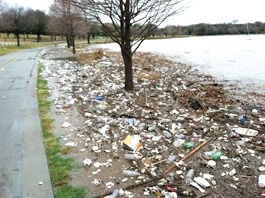
By Naïma Hill
We’ve been spending our weekends driving all throughout Dallas County in the endless search for an affordable place to live. As much as I’d like to gripe about the abundance of super-sized, overpriced houses, this story is not about the nauseating real estate market. I found something else even more disturbing.
Our city landscape is beautiful. Neighborhoods full of large trees, tiny creeks, rolling hills in areas, and then … trash. Litter on the ground, in bushes and, somehow, high up in trees. The visible trash is overwhelming. That got me thinking, “What are we not seeing?” I started to think about the most polluted/toxic places in Dallas County. Here’s the list I came up with:
1. PCBs in Mountain Creek Lake. A student recently asked me about pollution in Mountain Creek Lake, and after some research, I realized I had forgotten about the horrors down the street. Mountain Creek Lake was home to a Naval Air Force Base on land leased from the city of Dallas from the 1940s to late 1990s. During those dirty years, disposal of diesel, jet fuel, hydraulic oil, sewage and other chemicals was done by burying, burning or dumping it down the drain. This led to extremely high levels of Polychlorinated Biphenyls (PCBs) in groundwater and soil. PCBs are common man made organic compounds used to build a variety of materials. After discovering the toxicity of PCBs, they were finally banned in 1979. PCBs do not readily decompose in the environment and can remain in systems for long periods of time. To this day, Texas Parks and Wildlife recommends only eating 8oz of channel catfish or white bass once per month out of Mountain Creek Lake. It’s safe to say … don’t fish and eat there.
2. Don’t live anywhere near a fracking site, which in North Texas can be a challenge! The chemicals used in fracking fluid contaminates local well water. In a study published in 2015, of 550 wells in the Dallas area, more than two thirds were found with volatile organic compounds such as toluene, ethylbenzene, xylene and the known carcinogen, benzene. The EPA has also issued research and information showing fracking contaminating ground water. Not the kind of stuff I want to bathe in or drink.
3. The Trinity River. I seesaw about the health of the Trinity — probably because its health actually does seesaw. With our recent heavy rains in North Texas, the Trinity is the collection site of heavily polluted surface runoff, runoff that contains oil, gas, chemicals, fertilizers, pesticides and physical trash. The river overruns its banks, and the erosion continues on. Check out the major erosion under the pedestrian Continental Avenue Bridge. There are no trees and plants to hold the soil in place. More sediment is washed into the water, affecting the ecological system. Water that flows over the banks yet inside the levees stands in littered pollution, unmoving, taking in heat from the sun and becoming a perfect bacteria breeding ground.
4. Nearby the Trinity at Singleton and Mockingbird, the RSR Company site has not been removed from the Superfund National Priority List yet. RSR operated a lead smelter from 1920s until 1984 (pictured above) and disposed of waste materials on site and in area landfills. Lead was in the soil, and studies in the 1990s confirmed high blood lead levels for residents and children living in the area. Cleanups occurred, but the site remains, and the neighborhood marches on.
Is there any reduced toxic space in the Dallas area? If we factor in the air, the answer is no. The American Lung Association ranks Dallas within the Top 10 of most polluted in the nation. This is due to high levels of the air pollutant ozone within our urban heat island city.
This kind of information drives me to be better. Everything I purchase, use and every decision I make impacts the same city I want to be cleaner. I’m not sure where we will land, but I know it is sure to be polluted. I want to live, work and play in a pollution free city, don’t you?!
